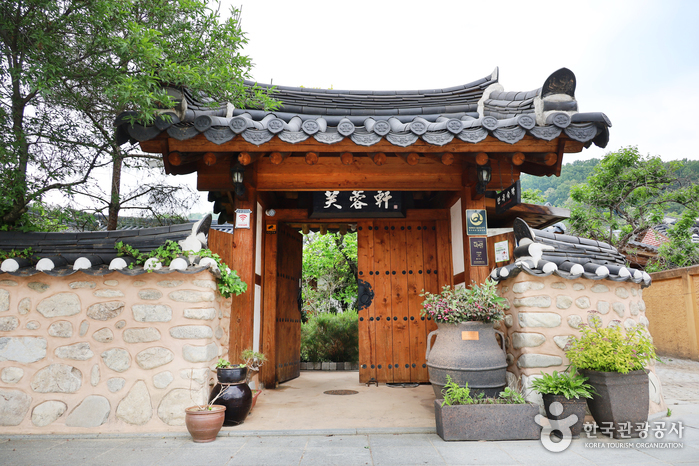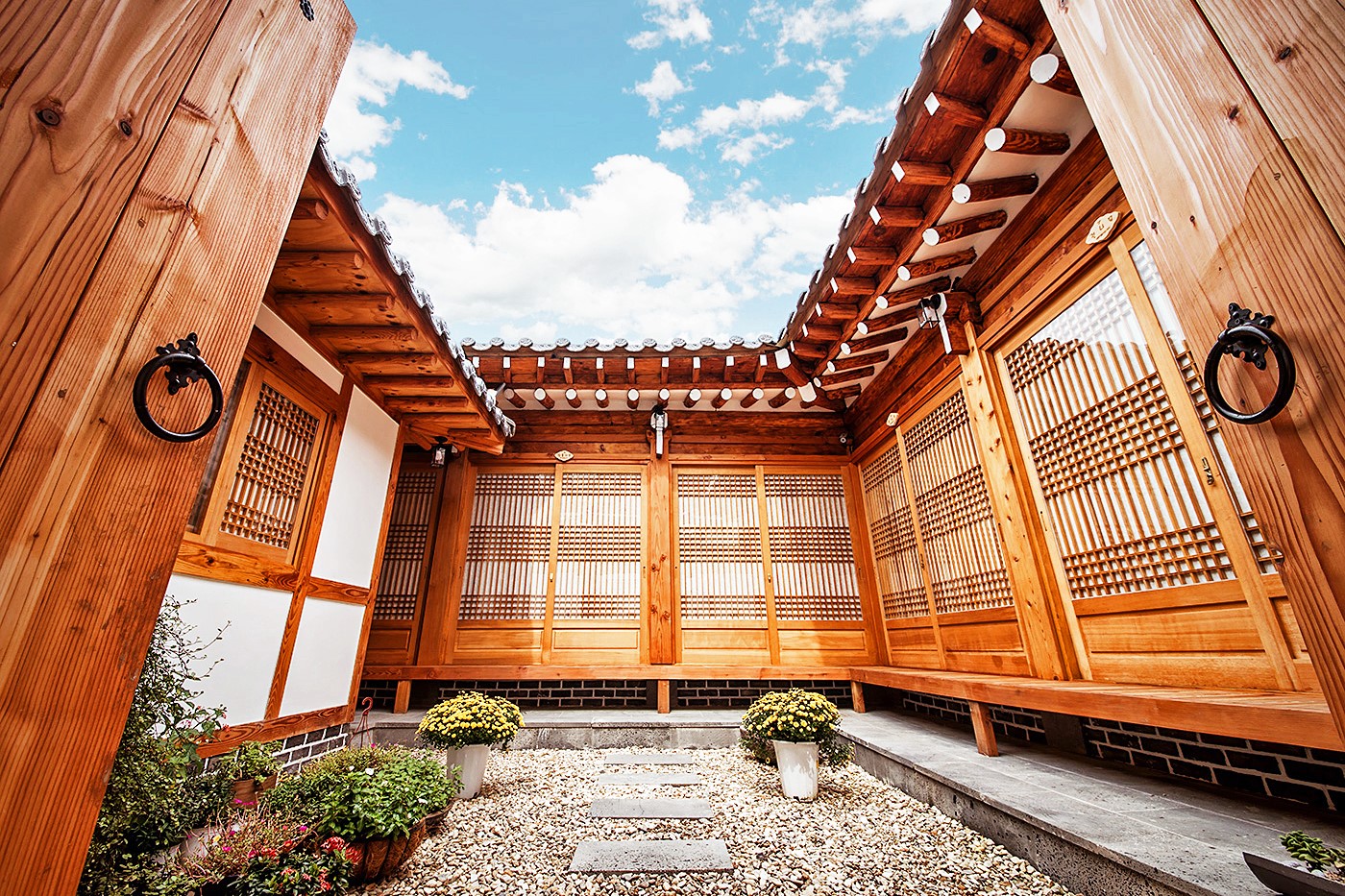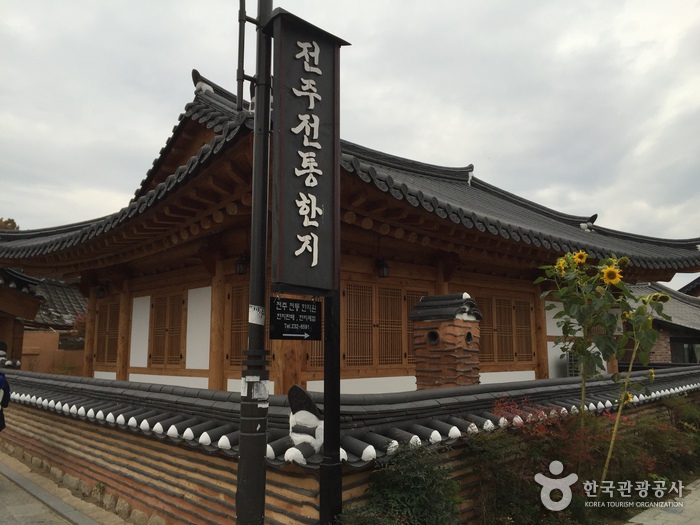Bu Yong Heon (부용헌)
19.1Km 2025-06-17
149-3, Hyanggyo-gil, Wansan-gu, Jeonju-si, Jeonbuk-do
Buyongheon is located in Jeonju Hanok Village. Precisely speaking, Buyongheon is the very next door to Jeonju Hyanggyo (Confucian Temple and School). Across the alley are Jeonju Hyanggyo Culture Center and Wanpanbon Culture Center. If you walk a few more steps, you will reach Jeonju Hanbyeok Culture Center where you can see various performances and experience the culture and foods of Jeonju. Omokdae can be seen from the garden of Buyongheon. Across the Jeonjucheon Stream is the National Intangible Heritage Center.
The beginning of Buyongheon is deeply related with Jeonju Hyanggyo. In around 1935, the local bureaucrats lived around the Hyanggyo after building 12 houses one after another. Most of them came from rich families. These collective houses were called Buyong Houses, which meant rich houses. The name Buyongheon originated from Buyong Houses. The rooms of Buyongheon are composed of Toenmaru Bang, Daecheong Maru Bang, Large Daecheong Maru Bang and Big Sarangchae. The interior of the rooms looks neat with the beauty of blank space as they excluded unnecessary decorations. Carefully prepared breakfast is served upon request made in advance. Visitors can also experience traditional culture such as traditional etiquette education and Korean paper art.
In fall, the yellow leaves of the ginkgo tree in the garden of Jeonju Hyanggyo lights up the roof of Buyongheon. It is recommendable to walk along the Jeonjucheon Stream and take pictures of the colorful murals and the cafes in the Jaman Mural Village located on the left sie of the Hanok Village. It takes 15 minutes from Jeonju Station and 10 minutes from Jeonjuu Express Bus Terminal to Buyongheon by taxi.
Veteran Kalguksu (베테랑칼국수)
19.1Km 2025-07-14
135, Gyeonggijeon-gil, Wansan-gu, Jeonju-si, Jeonbuk-do
Jeonggahanog / 정가한옥
19.2Km 2025-03-05
78-3, Girin-daero, Wansan-gu, Jeonju-si, Jeonbuk-do
+82-10-9934-1300
Jeongga Hanok is a space where the traditional beauty of hanok and the modern comfort co-exists. The newly built Hanok is neat and pleasant. When you enter the small cobbled yard, the porch and the eaves will welcome you, and you’ll find that the rooms are filled with delicate wood fragrance. The interior is furnished with Korean cypress trees and red clay. In particular, the Cypress Tree room is all made of cypress trees, from the walls to the ceiling, making guests feel like they are lying in a forest. Maple Room and Ginkgo Tree Room, meanwhile, have attics.
Jeongga Hanok faces Jeonju Hanok Village with the Girin-daero in the middle. Hanok Village is just across the road. Major attractions such as Gyeonggijeon, Jeondong Catholic Cathedral, and Jeonjuhyanggyo Confucian School are all within walkable distance. Omokdae, which offers an unhindered view of Hanok Village, is located over the pedestrian overpass. Jaman Mural Village, famous for colorful mural and cozy cafes, is about 300 meters away and a great spot for selfie lovers.
Gaeunchae 2 (가은채2)
19.2Km 2025-07-18
100-20, Hanji-gil, Wansan-gu, Jeonju-si, Jeonbuk-do
Gaeunchae 2 is the sister hanok of Gaeunchae in Jeonju Hanok Village, Jeonbuk-do. It’s a traditional red clay-walled hanok with ondol underfloor heating, exposed roof beams and hanji wallpaper and flooring - creating a beautiful and distinctive hanok interior. It has a small hallway which is good for storing luggage or just to sit and chat. In the garden are sculpted stone lanterns and tigers. Local attractions such as Jeondong Cathedral and Gyeonggijeon Shrine are a short walk away.
Bukyungdang [Korea Quality] / 부경당 [한국관광 품질인증]
19.2Km 2024-04-07
99-5, Hanji-gil, Wansan-gu, Jeonju-si, Jeonbuk-do
+82-10-5327-8736
Located at the heart of the Jeongju Hanok Village, Bugyeongdang is a beautiful traditional 60-year old Hanok.
Traditional floor, roof tiles, and jar stands next to stone walls, while small garden and flower beds reflect the architect couple's attentive hands. As a Hanok with one of the prettiest gardens in Jeonju Hanok Village, it is a good place to appreciate the garden flowers and enjoy the unique laid-back atmosphere of Hanok while sitting on the floor. The place is close to major tourist attractions including Imokdae, Gyeonggijeon, Jeondong Catholic Cathedral, and Hyanggyo.
The owner, who was born and raised in the Jeonju Hanok Village, describes must-go sites like a tour guide and introduces undiscovered great restaurants or things-to-do to the guests. As the owner, who had long been engaged in architecture, takes care of the Hanok, the building always stays clean and in good condition.
In the shared kitchenette, guests can prepare simple breakfast for themselves with the dishes and cups made by the wife of the owner herself. Luggage storage services before check-in and after check-out, and description of tourist attractions are provided.
Catedral Católica de Jeon-dong en Jeonju (전주전동성당)
19.2Km 2024-10-15
Taejo-ro 51, Wansan-gu, Jeonju-si, Jeonbuk-do.
La Catedral Católica de Jeon-dong fue construida en 1914 al estilo occidental y fue designada como Sitio Histórico. Es la estructura del estilo occidental más grande de las provincias de Jeollanam-do y Jeollabuk-do. La catedral es elegante con sus paredes de ladrillos y lo más encantador es la entrada y la torre de campana. La entrada de la iglesia tiene una forma arqueada que le da un toque bizantino, mientras que la pequeña torre de campana ubicada en el centro agrega una belleza singular. Desafortunadamente, algunas partes de la catedral fueron destruidas por un incendio en 1988.
Jeonju hanok house [Korea Quality] / 전주한옥숙박체험관 [한국관광 품질인증]
19.2Km 2024-04-07
56-1, Eunhaeng-ro, Wansan-gu, Jeonju-si, Jeonbuk-do
+82-10-3659-0055
Jeonjuhanok Korean House is a traditional Korean house built more than 60 years age, and it was recently remodeled for visitors to see and experience an old traditional Korean house. It’s conveniently located on the street called "Eunhaeng-ro" right in the middle of Jeonju Hanok Village for those visiting the area to take a tour of the hanok village. Although it's in the middle of the village, it's quiet inside because it's located at the end of a long, wide alley, which has the feel of an art gallery thanks to the lighting. There is a table in the yard in front of the ‘ㄱ’-shaped house. Behind the house is a café where breakfast is served. The house has an open space between the rooms called "toetmaru", which serves as a living room as in all traditional Korean houses. It’s where Koreans used to rest under the warm sunlight in the old days. The guests must pass through this "toetmaru" to get to the roms.
Jeonjuhanok Korean House has seven "ondol (floor-heated)” rooms with a loft. The rooms are clean and have a simple interior with a wooden ladder to the loft, which is a favorite place for most kids staying here with their parents. Each guestroom is furnished with a water purifier. The guesthouse serves toast, caffe Americano, fruits, and tea for breakfast.
Lago Ajung (아중호수)
19.2Km 2024-05-14
Ua-dong 1-ga 1111-5, Deokjin-gu, Jeonju-si, Jeonbuk-do
Centro Tradicional del Hanji en Jeonju (전주전통한지원)
19.2Km 2024-04-07
Hanji-gil 100-10, Wansan-gu, Jeonju-si, Jeonbuk-do
Jeonju ha sido el mayor productor de papel tradicional hanji durante más de cien años. Aún mantiene esta orgullosa tradición y el Centro Tradicional del Hanji pretende preservar las técnicas tradicionales de fabricación de papel y ser el centro de la industria del hanji. Más del 80 por ciento del papel producido en el centro es exportado a Japón, y el resto se usa en Corea. El centro produce, expone y vende hanji para caligrafía, pinturas orientales y otros elementos artesanales.
Ihwa Gotaek [Korea Quality] / 이화고택 [한국관광 품질인증/Korea Quality]
19.2Km 2024-10-15
91, Hanji-gil, Wansan-gu, Jeonju-si, Jeonbuk-do
This “ㄱ”-shaped hanok (traditional Korean house) building, standing to the right-hand side of the gate, is an old house with a history of more than 120 years that was transplanted to its present site from its original location in Buan’s local Confucian school in Jeollabuk-do. The building to the left across the courtyard is a “ㄷ”-shaped building with a history of about 70 years. The buildings at Ihwa Gotaek stick to the classics of hanok architecture, featuring the trio of open wooden-floor spaces called numaru, toenmaru, and jjongmaru.
There are 8 rooms in total, 1 four-person room with eight maximum occupancy, and 7 two-person rooms with maximum occupancy of four. All rooms have their own attached restrooms. Guests are served with complimentary seasonal refreshments, either a sweet rice punch (sikhye) or shaved ice with sweetened red beans (pat bingsu) made in-house, and for breakfast guests have a wonderful spread that includes bibimbap, rice cake soup, black sesame porridge, and bean-powder-coated rice cake, served in traditional bronze tableware. Guests can also place their reservations for traditional cultural programs like pansori (epic chant), tea ceremony, natural dye, and Korean paper art, and enjoy a discount of 30% in hanbok (traditional Korean clothes) rental.



![Bukyungdang [Korea Quality] / 부경당 [한국관광 품질인증]](http://tong.visitkorea.or.kr/cms/resource/29/2593529_image2_1.jpg)

![Jeonju hanok house [Korea Quality] / 전주한옥숙박체험관 [한국관광 품질인증]](http://tong.visitkorea.or.kr/cms/resource/90/2531490_image2_1.jpg)

![Ihwa Gotaek [Korea Quality] / 이화고택 [한국관광 품질인증/Korea Quality]](http://tong.visitkorea.or.kr/cms/resource/50/2707550_image2_1.jpg)
 Español
Español
 한국어
한국어 English
English 日本語
日本語 中文(简体)
中文(简体) Deutsch
Deutsch Français
Français Русский
Русский